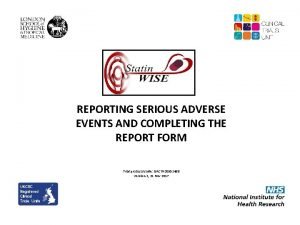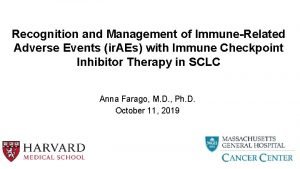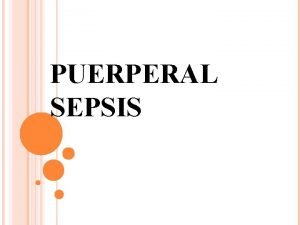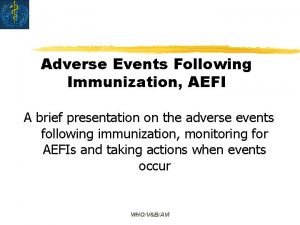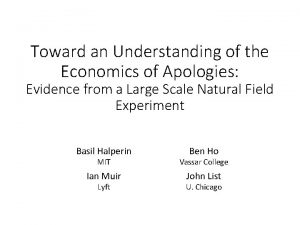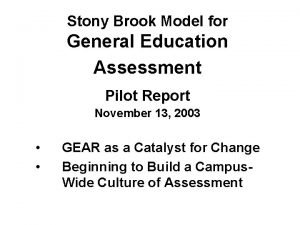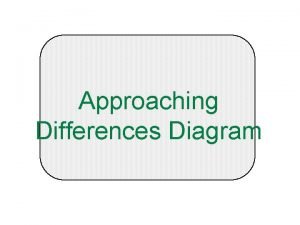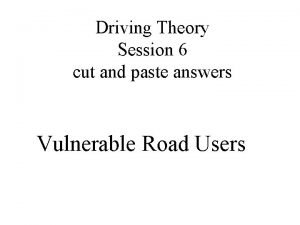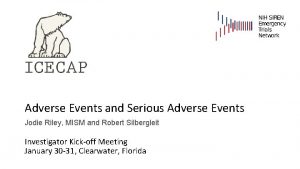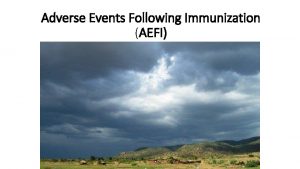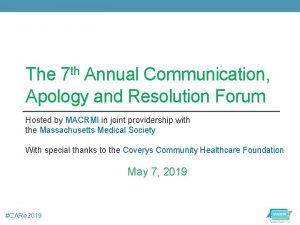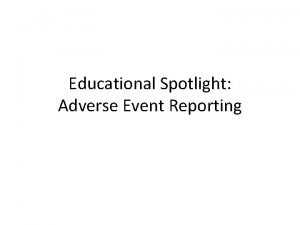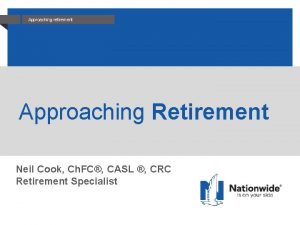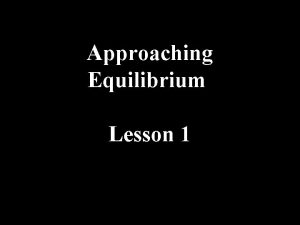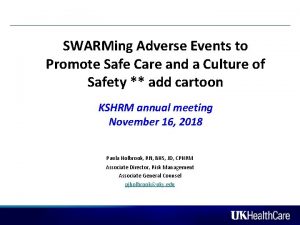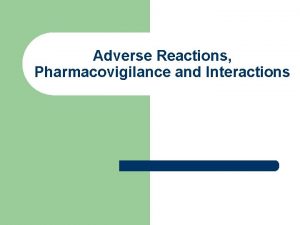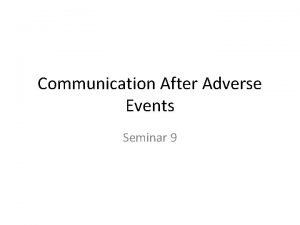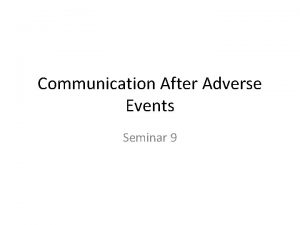Communication Apology and Resolution CARe Approaching Adverse Events





























- Slides: 29

Communication, Apology, and Resolution (CARe): Approaching Adverse Events with Empathy Name, Credentials, etc. © MACRMI 2016

Objectives • • • Describe the benefits of the CARe program for patients, clinicians, and health care systems, in comparison to a traditional liability model. Describe the essential elements of a successful CARe program. Describe the key CARe action steps to take immediately following an adverse event.

Adverse Event - Definition • • Definition: An injury that was caused by medical management rather than the patient’s underlying condition. Adverse events can result from errors, but they do not necessarily result from errors (i. e. a bad outcome from a procedure, adverse patient reaction to medication).

Why do patients sue? • “Studies show that the most important factor in people’s decisions to file lawsuits is not negligence, but ineffective communication between patients and providers. ” • “Malpractice suits often result when an unexpected adverse outcome is met with a lack of empathy from physicians and a perceived or actual withholding of essential information. ” Clinton & Obama, NEJM 2006 Vincent C, Lancet 1993

Mistakes – Clinicians are human! • • 100% of Clinicians make mistakes. The goal is to make sure current mistakes do not equal future mistakes. It’s always nice to break up the presentation with videos. Here’s a suggestion. Ted talk excerpt https: //www. ted. com/talks/brian_go ldman_doctors_make_mistakes_c an_we_talk_about_that? language =en

Adverse Event – Sample Case • • • Mr. Negashe calls the hospital Patient Relations office to voice a complaint that his doctor never provided information about blood work drawn during a clinic visit, and that in the meantime he had to be admitted to the hospital. He went to the emergency room when he developed blurry vision, and was admitted to the ICU where he learned that he had diabetes. He is worried that his vision problems are permanent. He is now insulin dependent and thinks that may not have been the case if detected earlier. He works as a driver and has been unable to work for several weeks. He is calling to simply to voice his dissatisfaction and alert the hospital to the problem. He does not indicate an expectation.

Adverse Event – Sample Case • • Patient Relations reviews the case and learns that the patient had an elevated Hgb. A 1 C several months earlier, and follow-up was encouraged. When he did return he was seen by the physician, who drew a repeat test but did not follow-up with the patient. The patient called the clinic twice for results and these calls were forwarded to the physician but no return call was made. The clinic did not have a “closed loop” system to identify whether calls had been returned. The Hgb. A 1 c was markedly elevated on repeat test. Peer review confirms that immediate follow-up was indicated in this situation, as the patient was at significant risk of becoming acutely ill.

Traditional approach to mistakes 1. 2. Pretend they never happened, don’t talk about them. “Deny and Defend, ” anything that is already known, and hope patients never show up in court.

What is wrong with the Status Quo? • Damaging to patient/provider relationship • Inefficient and expensive • Impedes patient safety improvement Patients Providers • Thwarts patient safety improvement • Drives over-utilization Health Care System • Damaging to future patients • Negative health impacts • Costly • Drives up overall cost of healthcare • Compromises access to care Gallagher Arch Int Med 2006; Boothman, Front. Health Svcs Mgmt 2012

What is Communication, Apology, and Resolution (CARe)? • • Communicate with patients and families when unanticipated adverse outcomes occur. Investigate and explain what happened. Implement systems to avoid recurrences of incidents and improve patient safety. Where appropriate, apologize and offer fair financial compensation without the patient having to file a lawsuit.

Principles of CARe • • • Compensate patients quickly and fairly when unreasonable medical care caused injury. If the care was reasonable or did not adversely affect the clinical outcome, support caregivers and the organization vigorously. Reduce patient injuries (and therefore claims) by learning through patients‘ experiences. “Nurturing a Culture of Patient Safety and Achieving Lower Malpractice Risk Through Disclosure: Lessons Learned and Future Directions. ” Boothman, et al; Frontiers of 11 Health Service Management 28: 3; study at the University of Michigan Health System

Why CARe? Status Quo CARe Reactive Proactive Adversarial Advocacy Culture of secrecy Denial Individual blame Patient/MD isolation Fear Defensive medicine Full disclosure / transparency Apology (healing) System repair Supportive assistance Trust Evidence-based medicine 12

Does CARe work? • • • University of Michigan Health System Stanford Hospitals and Clinics AHRQ Grant Awardees • • • Washington Illinois Texas New York Massachusetts (Planning Grant)

6 Types of Liability Costs Types of Events Before After 5 4 3 2 1 0 Lawsuits All Other Claim = “any request for compensation for an unanticipated medical outcome whether initiated by the patient or by disclosure. ” Mean Costs/mo. /$1000 revenue Claims/ Mo. /100 K Pt. Encounters University of Michigan Health System Lawsuit 20 18 16 14 12 10 8 6 4 2 0 Non-Lawsuit Before After Kachalia et al, Ann Intern Med 2010

Stanford’s PEARL Results Metric Desired Result Observed Result Comment Reporting Pattern Faster Unchanged Average incident to report lag is one year Frequency Lower Annual reported claims dropped from 23 to 15 Closing Pattern Faster Inconclusive Small number of closed claims Severity Lower Inconclusive Some large post-PEARL closed claims Overall Cost Lower 38% reduction over 5 years * Reinvestments in Loss Control Programs vs. Premium Rebates and Holidays http: //theriskauthority. com/ 15 © The Leland Stanford Jr. University 2013

The Massachusetts Pilot Sites Site #Beds Location Teaching (Y/N) Beth Israel Deaconess Medical Center 642 Inner City Y BID-Milton 88 Community N BID-Needham 58 Community N Baystate Medical Center 716 Inner City Y Baystate Franklin Medical Center 93 Community N Baystate Mary Lane Hospital 31 Community N Atrius Health* n/a Ambulatory N Sturdy Memorial* 128 Community N *Not yet in full implementation 16

Massachusetts Alliance for Communication and Resolution following Medical Injury “CARe” (Communication, Apology, and Resolution) is MACRMI’s preferred way to reference the process.

CARe Algorithms There are two CARe Algorithms: • A “filter” to determine whether an adverse event case should go through the full CARe process • • “Defining a CARe Case” The full CARe process that will be followed if a case is selected by the filter • “CARe Protocol”

“Defining a CARe Case” –the Filter If an internal investigation team determines that… The standard of care was not met, AND • The unmet standard of care caused significant harm …the case moves to the full CARe Protocol •

CARe Insurer Case Protocol • • • If selected by the “filter, ” case is referred to Insurer as CARe case Case reviewed by insurer and external experts CARe cases will proceed with a meeting with insurer, patient’s attorney, and providers (if applicable) to formally apologize, discuss the case, and offer compensation

CARe Insurer Case Protocol Potential Outcomes

Communication, Apology and Resolution Timeline Within… 24 -48 hours Patient Safety Alerted Support services for providers and patients launched Discussion with patient regarding error and known facts (1, 2) 2 -4 weeks Internal investigation takes place Patient Safety and Patient Relations maintain contact with providers and patients respectively (3) 1 -3 months 2 -5 months Determination of CARe criteria fit Providers, Chiefs, and Directors consulted Team huddle; designee conducts Initial CARe Communication with the patient; connects them to Insurer for record release (4, 5) Insurer reviews case and develops offer parameters Provider/System Allocation by insurer Insurer invites patient to CARe Initial Meeting; recommends that counsel also attend Lessons learned implemented at site (6, 7, 8, 9) 3 -6+ months Initial meeting with insurers, providers, patient safety staff, patient, counsel, and other parties. Additional meetings occur as necessary. Final offer to patient made and accepted or rejected. (10, 11)

Adverse Event Case - Resolved • Mr. N. received an explanation, an apology and compensation • • Compensation based on expenses encountered, lost work, pain and suffering. Payment was determined and made by hospital’s insurer on behalf of the hospital and physician With physician’s endorsement, responsibility was apportioned 50/50 Case was shared in multiple institutional forums to prevent recurrence

Sample Case – Mrs. Alcott • • Mrs. Alcott called her PCP’s office in September about a CT scan she had in March prior to undergoing an emergent cholecystectomy. She said she heard from a specialist that there were some “worrisome findings” on it that should have been followed up on. The nurse at the PCP’s office read her the report, which noted that a pelvic ultrasound was recommended for further evaluation of an adnexal enlargement. Mrs. Alcott was extremely upset because she had just been diagnosed with ovarian cancer, and asked that a surgeon call her back to explain to her why this was never followed up on. An attending surgeon who was involved in her follow up care from the hospital attempted to contact the patient, but the call was not returned. A pre-litigation notice was filed on behalf of the patient by her attorney shortly after. The hospital’s quality staff arranged a meeting between Mrs. Alcott and her attorney, the Surgery QI Director, and an attorney from the Insurer to discuss what happened, apologize for the error that was made, explain how it will be prevented in the future, and to work with the patient compensate the patient for the potential loss she experienced in this delay of diagnosis. The patient and the providers involved in the meeting felt that this meeting to explain, apologize, and discuss the corrective actions was extremely helpful in the healing process for everyone. 4 months later, the parties had reached an agreement and the case was resolved.

For Clinicians: Steps following an Adverse Event • Step 1: Report the event and get help

Steps following an Adverse Event (cont. ) • • Step 2: Communicate with the patient/family about the event; be empathetic and use statements of regret (“I am so sorry this happened to you…”); discuss facts known at this time and do not speculate or blame others. A note on Apology: • • 1. Statements of Regret – Always! 2. Apology of Fault – Once facts are known (if applicable)

Steps following an Adverse Event (cont. ) • • Step 3: Document the communication with the patient/family in the record; facts, who was present, and results of conversation. Step 4: Check back in with the patient/family and discuss with them the findings and any systemic improvements to be made once all facts are known and root causes have been determined.

What else helps CARe succeed? • • Leadership buy-in Baseline culture of safety • • • Staff • • • Root cause analysis and safety improvement Integration of risk management and patient relations A program manager Commitment from risk management/patient safety Support • • Clinician Peer Support Patient resources

Questions? Any Questions? Contact info: Please visit the MACRMI website for downloadable resources, blogs, discussion boards, and more: www. macrmi. info. Thank you!
 Adverse events in hospital
Adverse events in hospital Adverse events in hospital
Adverse events in hospital Puerperal endometritis
Puerperal endometritis Aefi examples
Aefi examples Thank you and apology letter
Thank you and apology letter High resolution low resolution
High resolution low resolution Apology poem examples
Apology poem examples Who considers poetry a mother of lies
Who considers poetry a mother of lies I owe you apologies
I owe you apologies Apology
Apology Socrates teaching method
Socrates teaching method How many syllables are in helicopter
How many syllables are in helicopter Axe brand apology
Axe brand apology Tertiary level of care
Tertiary level of care Mutually exclusive vs non mutually exclusive
Mutually exclusive vs non mutually exclusive Significant life events health and social care
Significant life events health and social care Conflict resolution skills
Conflict resolution skills The great gatsby chapter 8 summary
The great gatsby chapter 8 summary When hair ribbons are removed in the giver
When hair ribbons are removed in the giver Approaching meeting exceeding
Approaching meeting exceeding Exceeding meeting approaching
Exceeding meeting approaching Extracoronal retainer
Extracoronal retainer Types of direct retainers
Types of direct retainers Approaching differences diagram
Approaching differences diagram What should you do when passing sheep on a road
What should you do when passing sheep on a road Approaching vehicle audible system
Approaching vehicle audible system A martian lander is approaching the surface
A martian lander is approaching the surface The sound of approaching grain teams
The sound of approaching grain teams Requirements of direct retainers
Requirements of direct retainers Adverse reaction definition
Adverse reaction definition
